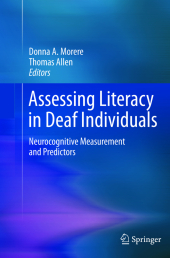 Neuerscheinungen 2015Stand: 2020-02-01 |
Schnellsuche
ISBN/Stichwort/Autor
|
Herderstraße 10
10625 Berlin
Tel.: 030 315 714 16
Fax 030 315 714 14
info@buchspektrum.de |

Thomas Allen, Donna Morere
(Beteiligte)
Assessing Literacy in Deaf Individuals,
Neurocognitive Measurement and Predictors
Herausgegeben von Morere, Donna; Allen, Thomas
2012. 2015. xvi, 268 S. 235 mm
Verlag/Jahr: SPRINGER, BERLIN; SPRINGER NEW YORK; SPRINGER 2015
ISBN: 1-489-99205-7 (1489992057)
Neue ISBN: 978-1-489-99205-5 (9781489992055)
Preis und Lieferzeit: Bitte klicken
This major contribution to improving education for the hearing impaired provides psychometric data for the deaf across numerous neurocognitive measures and introduces an inclusive test toolkit for assessing their academic skills and cognitive functioning.
Humans´ development of literacy has been a recent focus of intense research from the reading, cognitive, and neuroscience fields. But for individuals who are deaf-who rely greatly on their visual skills for language and learning-the findings don´t necessarily apply, leaving theoretical and practical gaps in approaches to their education.
Assessing Literacy in Deaf Individuals: Neurocognitive Measurement and Predictors narrows these gaps by introducing the VL2 Toolkit, a comprehensive test battery for assessing the academic skills and cognitive functioning of deaf persons who use sign language. Skills measured include executive functioning, memory, reading, visuospatial ability, writing fluency, math, and expressive and receptive language. Comprehensive data are provided for each, with discussion of validity and reliability issues as well as ethical and legal questions involved in the study. And background chapters explain how the Toolkit was compiled, describing the procedures of the study, its rationale, and salient characteristics of its participants. This notable book:
Describes each Toolkit instrument and the psychometric properties it measures.
Presents detailed findings on test measures and relationships between skills.
Discusses issues and challenges relating to visual representations of English, including fingerspelling and lipreading.
Features a factor analysis of the Toolkit measures to identify underlying cognitive structures in deaf learners.
Reviews trends in American Sign Language assessment.
Assessing Literacy in Deaf Individuals is an essential reference for researchers, graduate students, clinicians, and other professionals working in the field of deafness and deaf education across in such areas as clinical child and school psychology, audiology, and linguistics.
Preface.- Section I. Rationale and Participant Characteristics.- Chapter 1. The "Toolkit Project": Introduction.- Chapter 2. The VL2 Toolkit Psychometric Study: Summary of procedures and description of sample characteristics.- Section II. Cognitive Functioning.- Chapter 3. Measures of General Cognitive Functioning.- Chapter 4. Measures of Visuospatial Ability.- Chapter 5. Measures of Memory and Learning.- Section III. Academic Achievement.- Chapter 6. Measures of Reading Achievement.- Chapter 7. Measures of Writing, Math, and General Academic Knowledge.- Section IV. Linguistic functioning.- Chapter 8. Measures of Expressive Language.- Chapter 9. Measures of Receptive Language.- Chapter 10. Fingerspelling.- Chapter 11. Issues and Trends in Sign Language Assessment.- Chapter 12. Analysis of Responses to Lipreading Prompts as a Window to Deaf Students´ Writing Strategies.- Section V. Further Analyses and Translational Implications.- Chapter 13. Underlying Neurocognitive and Achievement Factors and Their Relationship to Student Background Characteristics.


